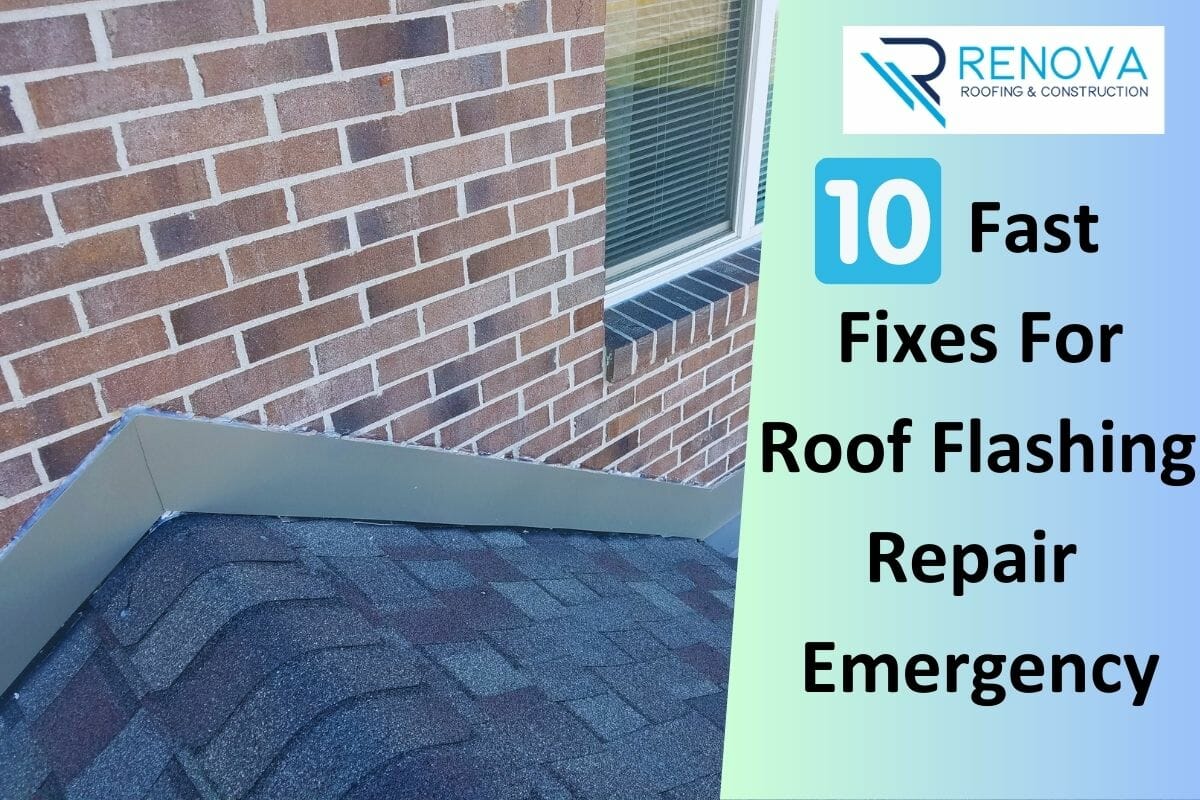When a storm hits, the last thing you want is compromised roof flashing causing leaks and water damage. Roof flashing protects your home from water infiltration at vulnerable points. However, during emergencies, it’s crucial to have quick and effective solutions on hand to address any roof flashing issues promptly.
In this blog post, we will explore 10 fast fixes that can help you protect your property after a storm and keep yourself dry and worry-free. Let’s dive into these emergency roof flashing repair solutions to ensure storm protection for your home.
👉 10 Fast Fixes for Roof Flashing Repair
Here are 10 ways to quickly fix the flashing on your roof if a storm has caused damage and you are waiting for professional repairs:
1. Apply roof sealant or caulk
Roof sealant or caulk is an effective way to seal visible gaps or cracks in the flashing. Apply a high-quality product that is specifically designed for roofing applications. Ensure thorough coverage to create a watertight seal and prevent water from penetrating compromised areas.
2. Use roofing cement or tar
Roofing cement or tar can be applied to damaged flashing areas to create a waterproof seal. These materials are typically available in tubes or buckets and can be spread over the affected areas using a putty knife or a trowel. Follow the manufacturer’s instructions for proper application and drying time.
3. Install roof flashing tape
Roof flashing tape is a convenient and easy-to-use solution for temporarily sealing gaps or cracks in flashing. It is typically made of a durable, waterproof material with a peel-and-stick backing. Simply cut the tape to the desired length and apply it directly over the damaged areas, ensuring a secure and tight seal.
4. Secure loose flashing with roofing screws
If you notice any loose flashing during a storm, use roofing screws to secure it and prevent further movement. Carefully align the flashing and drive the screws into the surrounding roofing material, ensuring a tight and secure fit. This will help to minimize the risk of water infiltration through loose flashing.
5. Replace damaged flashing sections
If possible, replacing the damaged sections of flashing with new ones is an effective way to ensure a proper seal. Carefully remove the damaged flashing and install the new one, ensuring it fits snugly and covers the vulnerable areas. Use appropriate fasteners to secure the new flashing in place.
6. Add a layer of roofing membrane
On a flat roof, applying an additional roofing membrane over the flashing area can provide extra protection against water infiltration. This can be done using a compatible roofing membrane material, such as a self-adhesive or liquid-applied membrane. Follow the manufacturer’s instructions for proper application techniques and coverage.
7. Utilize roof patches or repair kits
Roof patches or repair kits specifically designed for temporary emergency repairs can seal compromised flashing. These kits typically include patching materials, adhesives, and instructions for application. Follow the guidelines to effectively cover the damaged areas and prevent water from entering through the flashing.
8. Install metal roof edge flashing
Metal roof edge flashing can be installed temporarily to protect vulnerable areas until permanent repairs can be made. Use appropriate fasteners to secure the metal flashing along the roof’s edges, such as the eaves. This will provide a temporary barrier against water intrusion during a storm.
9. Apply elastomeric roof coatings
Elastomeric roof coatings can temporarily cover and seal damaged flashing. This coating is designed to expand and contract with the roof’s movement, providing flexibility and durability. Apply the elastomeric coating over the compromised flashing areas, ensuring complete and even coverage.
10. Seek professional roof flashing repair services
In cases where the damage is extensive, or the temporary fixes are insufficient, it is recommended to contact a professional roofing contractor for immediate repair assistance. They have the expertise, experience, and specialized tools to accurately assess roof flashing issues and provide long-lasting solutions to protect your home.
Remember, while these fast fixes can help mitigate damage during a storm, it is important to schedule permanent repairs as soon as possible to ensure the long-term integrity of your roof. For a comprehensive understanding of roof flashing and to avoid common installation mistakes, be sure to check out our blog post: Top Roof Flashing Installation Mistakes and What To Do About Them.
Common Causes of Roof Flashing Damage
Several factors can contribute to roof flashing damage, making it necessary to address any issues promptly. Some common causes include:
- Age and weathering: Over time, roof flashing can deteriorate due to exposure to the elements, including UV radiation, temperature fluctuations, and precipitation.
- Poor installation or maintenance: Improper installation or inadequate flashing maintenance can result in gaps, loose sections, or improper seals.
- Extreme weather conditions: High winds, heavy rain, hail, or snowstorms can cause flashing to shift, crack, or dislodge.
Signs of Roof Flashing Problems
Detecting roof flashing problems early is essential to prevent water damage inside your home. Look out for these signs that may indicate issues with your roof flashing:
- Leaks and water damage on the ceilings or walls below the roofline.
- Visible gaps or cracks around roof transitions, such as chimneys or vents.
If you notice any of these signs, it’s crucial to address the problem promptly.
To learn more about how to determine if your damaged roof flashing is in need of repair or replacement, read our blog post: How To Tell If Your Damaged Roof Flashing Is In Need Of Repair Or Replacement.

Conclusion
Quick action is crucial during an emergency roof flashing repair to protect your home from water damage. By implementing these 10 fast fixes, you can temporarily address roof flashing issues and keep yourself dry and secure until permanent repairs can be made. However, for significant or long-term flashing repairs, contacting professionals like the team at Renova Roofing & Construction is highly recommended. With our expertise and experience in roofing services, we can provide professional assistance and ensure the integrity and longevity of your roof. Whether it’s roof flashing repairs, replacement, or any other roofing needs, Renova Roofing & Construction offers reliable and quality services to safeguard your home. Act now to secure your property and ensure peace of mind during stormy weather. Contact us at (601) 647-3433 for expert assistance with your roofing needs.
FAQs
A. It is recommended to seek professional assistance for complex or permanent roof flashing repairs to ensure proper installation and long-term effectiveness.
A. Temporary repairs are intended to provide immediate protection during a storm. Permanent repairs should be performed as soon as possible for long-term solutions.
A. Temporary fixes can offer waterproofing during a storm but are not as reliable or long-lasting as permanent repairs.
A. If the damage is extensive, the temporary fixes are not holding up, or the roof flashing repair requires specialized knowledge and equipment, it is recommended to call a professional for service.

